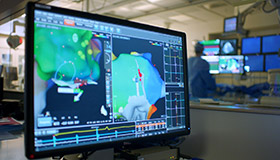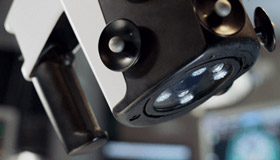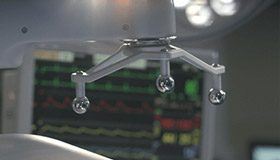Breaking the Wall of Silence
Loss of hearing was gradual
In September 2009, Karen noticed she was losing the hearing in her right ear. She also suffered from vertigo, getting dizzy and losing her balance. After ineffective visits to other doctors, she saw Dr. Douglas Chen, who diagnosed her with Ménière’s disease.
Then, on a trip to Florida, she lost more hearing in her left ear. On the trip home, she could only communicate to her husband through written notes.
By March 2015 she was completely deaf in both ears. She learned to fake it at the grocery store, anticipating questions such as “paper or plastic?”
What bothered her most was not being able to speak by phone to her children who live out west. She had to depend on her husband to call for hair appointments, and many other day-to-day tasks.
Surgery to restore hearing
During the summer of 2015, Karen had cochlear implant surgery for her right ear Allegheny General Hospital with Dr. Chen. There was some improvement, but this was greatly enhanced when she had a second implant in her left ear in July 2016. But she didn’t immediately return to her previous ability to hear.
Karen had to retrain her brain to hear differently. To practice, she listens to recorded books, while reading them at the same time. This helps her brain make new connections. It is a slow process, but she is thrilled with her progress. She tells her friends with hearing loss to consider the procedure and talk to their doctors.
What is Ménière’s disease?
Ménière’s disease is a disorder of the inner ear that causes dizziness, loss of balance, ringing in the ears and hearing loss. Ménière’s disease is:
- Caused by a buildup of fluid in the compartments of the inner ear
- Interferes with normal balance and signals between the inner ear and the brain
- Can develop at any age, but most often between 40 and 60 years old
Help for deaf children and adults
Cochlear implants are used in children and adults who are deaf or severely hard-of-hearing. An implant does not restore normal hearing but it can send sounds to a deaf person that they will relate to speech. Some older adults who have lost nearly all of their hearing may be able to use cochlear implants by learning to associate the signal from the implant with sounds they remember.
Cochlear implants send signals
A cochlear implant is a small, complex electronic device that can help to provide a sense of sound to a person who is profoundly deaf or severely hard-of-hearing. Part of the implant sits behind the ear and a second portion is surgically placed under the skin. It has:
- A microphone, which picks up sound from the environment
- A speech processor, which selects and arranges these sounds as signals
- A transmitter and receiver/stimulator, which converts the signals to electric impulses
- The signals are collected and sent to different regions of the auditory nerve
Deafness research and awareness
The National Institute on Deafness and Other Communication Disorders (NIDCD), part of the National Institutes of Health (NIH), conducts and supports research in the normal and disordered processes of hearing, balance, taste, smell, voice, speech, and language. Source: NIH/NIDCD





